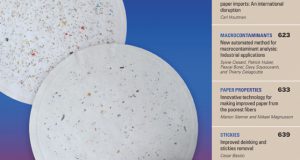One company is using data analytics to improve advanced control performance, lifetime management of consumable components, and predictive maintenance.
MARK WILLIAMSON
The Industrial Internet—or the Internet of Things, Industry 4.0, big data, cloud computing, and analytics—are attention-getting terms that are hard to escape these days. A flood of projections cite these related concepts as “the way of the future” for a wide variety of manufacturing, commercial, and public enterprises. But it is not a one-size-fits-all solution, as many companies have molded these concepts to their customers’ needs.
 In an exclusive Paper360° interview, Valmet’s Johan Pensar, director, Industrial Internet; and Johanna Newcomb, manager, advanced solutions and Industrial Internet, explain the implications of
In an exclusive Paper360° interview, Valmet’s Johan Pensar, director, Industrial Internet; and Johanna Newcomb, manager, advanced solutions and Industrial Internet, explain the implications of  Industrial Internet applications specifically for the pulp, paper, and energy industries.
Industrial Internet applications specifically for the pulp, paper, and energy industries.
Industrial Internet—that is, advanced and networked data analytics and utilization—impacts all stages of the production process. For Valmet, Industrial Internet means the ability to capture and share data and information from pulp, paper, and energy production machines and processes, and to use it for the customer’s benefit.
Paper360°: How does Valmet define the value to pulp and paper producers of Industrial Internet access and related analytical services?
Pensar: The main value of the Industrial Internet lies in the opportunities to improve the visibility and profitability of a mill’s operations. For example, think of the immediate support that can be provided by remotely-located experts with full insight into process conditions, solving the problems right here and right now, without the cost and loss of time associated with traveling. Production asset productivity increases by using data-driven predictive maintenance solutions that have in-built understanding of specific component wear, combined with optimized maintenance planning.
Newcomb: Plus, with a thorough understanding of the actual process behavior, significant savings are being generated through optimization of raw material, energy, production, yield, and quality. None of this is just wishful thinking. We have demonstrated that the lifetimes of consumable equipment like roll covers can be extended by 20 percent, energy consumption reduced by 5-15 percent, raw material and chemical consumption reduced by 10-20 percent, and production increased by 15 percent. These are real life cases where mills use data more efficiently and improve process productivity through our solutions.
Pulp and paper producers have made significant investments in information systems and manufacturing execution systems. What extra capability do these Internet-related services add?
Pensar: Those investments have laid a good foundation. Industrial Internet does not replace what you have; it uses the information existing in a new and more efficient way. Mills typically already have many systems producing volumes of reports and information. Often, there is no easy way to retrieve performance data from multiple applications, or multiple sites within a corporation, to get the full understanding of the operations. Industrial Internet provides ways to retrieve, consolidate, and analyze the data so that value-adding information is provided in an easily understandable way.
Newcomb: It is no longer enough to visualize data; customers expect to see data that is made sensible and practical. This includes holistic status, predictions, and recommendations based on machine and papermaking experience, to support our customers in decision-making and operations optimization. Industrial Internet solutions provide easier, more efficient ways for the mill and corporations to understand and improve upon how a mill stands in comparison to both industry and corporate benchmarks, as well as a mill’s own historical performance.
What extra infrastructure investment is required?
Pensar: Mills built during the last decades are typically instrumented and automated quite well. Therefore, the required investments in infrastructure can be relatively small and easily retrofitted to almost any existing plant infrastructure. This typically means facilitating the data collection from different systems and adding a gateway for data transfer.
Newcomb: You cannot improve what you don’t measure, so it is important to start from the customer objectives. At times, new instrumentation must be added to solve the particular challenges. For example, pulp quality, kappa, and brightness in pulp mills must be measured accurately. Or, as another example, in paper machine stock preparation systems a mill must know its fiber properties to model, control, and optimize strength or other paper properties, and to manage fiber blending and refining processes.
Remote data access and diagnostics have been offered within the pulp and paper industry for quite a few years. What are the differences or improvements today?
Pensar: The current upswing of the Industrial Internet is partly fueled by development in cloud computing and data communication—enabling data to be easily retrieved from many data sources combined, then analyzed and visualized. This allows new technology to be deployed for many types of value-adding solutions and services that earlier would have been difficult to accomplish with manual data access and analysis.
Newcomb: The combination of data, process automation, and service information allows combining areas of company expertise and helps everyone perform better as one team. We combine expertise from process equipment teams, automation and optimization teams, measurements and analyzers teams, and analytics experts.
Valmet has linked the capabilities of advanced controls with the Industrial Internet. What is the potential for better results?
Newcomb: While Valmet has offered APC and Performance Services for a long time, Industrial Internet technologies allow the elevation of automated control from sub-process level to total mill optimization. This means setting ideal targets between the process areas so the entire production process is balanced and optimized, while taking into account optimal production plans, as well as inventory and production constraints, from Advanced Planning and Scheduling solutions. In a fiber line, kappa levels in cooking, oxygen delignification, and bleaching stages can be set to achieve the targeted final brightness, kappa, yield, and chemical consumption, while Advanced Planning provides an optimal production plan. Also, specific constraints in process areas and inventory can be considered automatically. With Industrial Internet, the expected savings can be sustained over time, with changing production environments and mill objectives.
Pulp and paper process control systems can be comprised of thousands of measurement and control points. How can the monitored and analyzed points be prioritized? How big or small could this be?
 Pensar: True, a modern plant can produce enormous amounts of data. Typically, not all is fully used, and not all requires further analysis. Yet there are areas where mills need more thorough data analytics. It is important to take it step by step and focus on the business opportunities. Simply start from the areas where you see the greatest benefits—the low hanging fruit—and go from there. The data that is available in a mill usually allows the analysis, modeling, prediction, and optimization of almost any component or process. For some applications, the data required could be limited to a handful of signals, while in other cases hundreds or even thousands of signals are needed.
Pensar: True, a modern plant can produce enormous amounts of data. Typically, not all is fully used, and not all requires further analysis. Yet there are areas where mills need more thorough data analytics. It is important to take it step by step and focus on the business opportunities. Simply start from the areas where you see the greatest benefits—the low hanging fruit—and go from there. The data that is available in a mill usually allows the analysis, modeling, prediction, and optimization of almost any component or process. For some applications, the data required could be limited to a handful of signals, while in other cases hundreds or even thousands of signals are needed.
How real-time are the analysis functions and alerts? Could they be used on the production floor or in morning meetings?
Pensar: While many of the current services already produce long-term advice or reports for the morning meetings, there are applications like alerts and controls that need to run at real-time speed. This is solved by a solution where slow analytics is carried out in the cloud, while fast analytics and controls are carried out closer to the process.
Newcomb: Valmet customers have been sustaining and improving process performance with the help of remote data acquisition, together with analytical and expert services, for a long time. Customers report that this regular reporting helps to keep them in touch with production and costs—chemical and energy consumption, for instance. Many do use the daily reports in the morning meetings.
What is the role of key performance indicators (KPIs)?
Pensar: It may be difficult to get a good overview of the situation, as information often is scattered in multiple data sources. Centralized KPI monitoring can combine all those sources and helps to make sense of the large amount of data while improving the process performance. KPI calculations and dashboards can therefore be seen as fundamental tools for process optimization and decision support.
Newcomb: KPIs provide a “big picture” in support of the line optimization. As an example, for one facility, the yield increase of a fiber line optimization controls, supported by KPI calculations and visualization, resulted in a production increase of 2,000 ADT/y, while chemical consumption at the bleach plant was optimized.
How is maintenance and equipment reliability improved?
Pensar: Predictive models based on collected data can give a good understanding of when the component needs to be exchanged. Integrating this information into the maintenance management system opens possibilities to schedule planned shutdowns to reach the utmost efficiency and a high plant availability.
Our online condition monitoring systems have been used for many years by mill maintenance groups to improve mechanical reliability and to prolong lifetimes. Now, that diagnostic capability, plus fault analysis and “heads up” warnings, can be done remotely by our vibration analysis experts. For instance, a nickel refinery found that remote analysis and reporting has helped them prevent many catastrophic failures and avoid yearly gearbox rebuilds.
Maintenance is also improved as the access to information is becoming mobile. Today, the Valmet Maintenance Pad allows daily maintenance scheduling and tracking, documentation viewing, real-time process and condition monitoring, and mobile condition monitoring.
How do you ensure the security of customer process data?
Pensar: The access to customer data is secured using industry best practice measures to prevent any unauthorized access. A strong authentication of both customer and Valmet users, combined with a role-based access control, ensures that only users with a need to know can access the data. Customer will only have access to their own data, plus screened and anonymous benchmarking data.
How will the market for these services develop? What’s in the future?
Pensar: We see an increasing interest from the industry, and a lot of activities going on. This will probably grow significantly within the next few years. The Industrial Internet is also a tool that will transform existing services to a new level. This means that future services and products will largely rely on Industrial Internet technology.
Cloud computing and connectivity is now a norm in new products, while big data and advanced analytics methods are implemented for roll-cover condition monitoring, corrosion prediction, paper machine fabrics analysis, energy efficiency optimization, and production optimization—just to name a few. Also, in the development of mobile and wearable technology, Valmet is working on maintenance solutions that use augmented and virtual reality. With solid evidence about the benefits from the technology, these are moving into commercialized production while new solutions are being developed in collaboration with our customers.
Newcomb: Also, there are analytics solutions for process modeling from the pulp mill to final paper quality. Examples include modeling of paper strength and other paper properties, energy optimization across the plant, and further efficiency optimization of boilers with the help of big data. Digital services—and bringing Valmet expertise for customers to use in new ways—is on the way.
Mark Williamson is a journalist engineer based in Ontario, Canada. Contact him at [email protected].
Johan Pensar
Johanna Newcomb
Roll-cover lifetimes are being extended by up to 20 percent with big data and advanced analytics. Paper machine fabric lifetimes are also being analyzed and prolonged.
Members of Valmet’s advance process control team use the Industrial Internet to diagnose and solve mill problems and improve productivity.
 Paper 360
Paper 360


